Disclosure: Meeple Mountain received a free copy of this product in exchange for an honest, unbiased review. This review is not intended to be an endorsement.
My friend John was doing a teach of the 2022 release Sabika (Ludonova Games, distributed by Asmodee in the US). The massive play space has a rondel at the center of the board, along with areas for various tiles, scoring tracks, trade routes, and both minor and major building cards and tiles.
“So, you’ve got this rondel, you’ve got ‘paria’ points, you’ve got a market, you’ve got cards, and you’ve got a trade route with all of these ships. The rondel has three tracks, for building, trading with other cities…and a track where you have to write poems.”
The record scratched. “What or who am I supposed to be, exactly? I know in a lot of action movies these days, the contract killers also happen to be adept at things like hacking a government server, but it feels like a stretch that I am great at establishing trade routes, building the Alhambra, and writing poems!!”
And…that’s Sabika, a medium-to-heavyweight Eurogame design by Germán P. Millán (Bitoku), the Spanish designer who clearly has a taste when it comes to his design work. If that flavor is for you, read on. There’s a lot to like in Sabika, even if the final result is a bit finicky with its scoring mechanic.
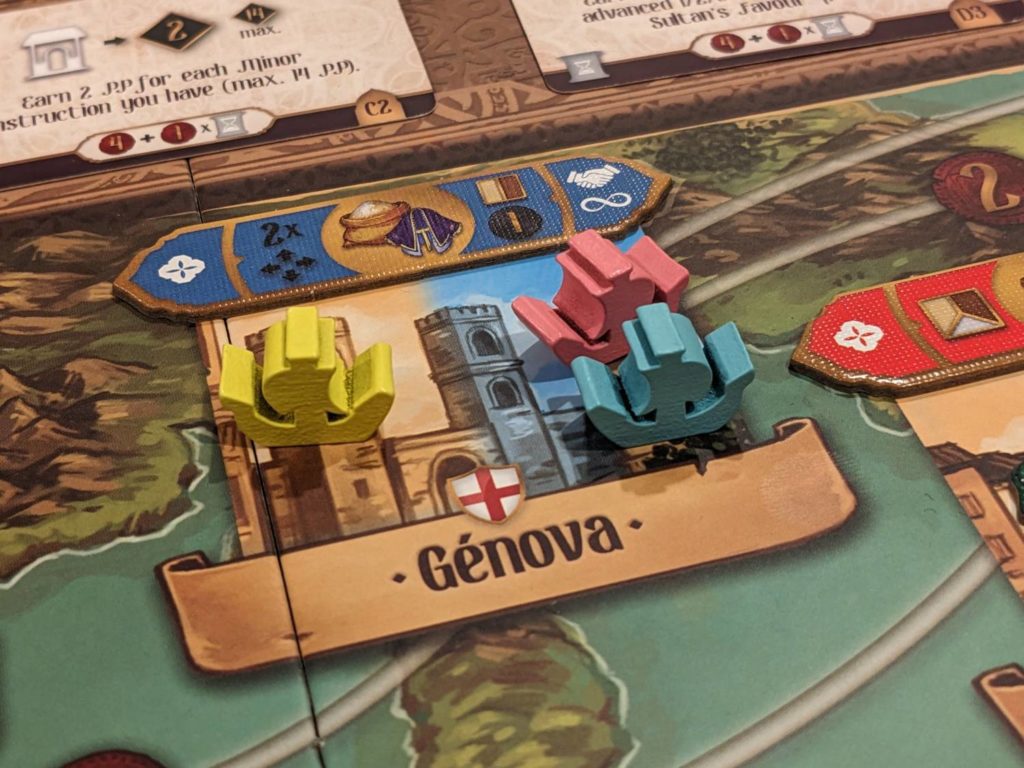
The Alhambra of Alhambras
Sabika is a 1-4 player worker placement rondel game that takes place in medieval times. Over a series of five rounds, players will take four main actions per round by placing their nobles (workers) on one of the game’s rondels, represented as circles within circles in the center of the board. Where Sabika differs from other rondel games, such as Glen More II: Chronicles, The Red Cathedral, and Crown of Emara, is the sheer number of rondels available: three.
In Sabika, these three rings make for fascinating fun. In the first round of the game, a player can move one of their four nobles from their player mat onto the rondel anywhere they would like, following a few rules. First, the nobles have to be in a space with no other nobles of that player’s color, and second, the nobles have to fit into their preferred rondel.
The two “big” nobles, the Master Builder meeples, can only take actions in spaces on the outer ring of the rondel. There, the Master Builders can take actions that fit for their role—constructing the Alhambra. Players have a few different choices; they can use a Builder to construct major or minor buildings, visit markets to conduct up to two trades, collecting resources at a major (wood and marble) or minor (wood and gypsum) quarry, or take an available Storehouse from the display, which will increase storage capacity on a player’s personal mat for all of their resources.
The middle ring of the rondel is where each player has a Merchant meeple. The actions here all align with extending trade routes between the cities shown on the bottom third of the main board. Players can also use their Merchant to secure raw materials that will later be processed for trading purposes with foreign markets. Merchants can also be used to Consolidate an existing trade relationship, which may lead to a bonus action or future income.
The inner ring is where the Poets come into play! This poetry thing feels a little clumsy, but in essence, this is the ring where players can carve poems that take on the form of ongoing player powers, one-time bonuses, and end-game milestones. Other actions on this ring include a cash grab of three bucks (cash is known as “dinars” in Sabika) plus a small boost for every pair of poems a player has in their possession, and the ability to reactivate any of your one-time bonus poems.
Some of the main actions result in card or tile effects that also provide secondary actions, so there are some chances to chain actions for a player that lines everything up just so. The combos here aren’t as juicy as the ones in a game like Tiletum, but there are still going to be a couple of nice chances in each game to chain 2-3 actions all at once.
After the first turn, players can move a meeple up to two spaces forward in a clockwise direction to take their next action. However, landing on a space with other meeples forces the active player to pay every other player at that space one coin. If a player cannot or refuses to move a worker, they can take a worker back to their player mat to “rest” and receive three coins…but they also lose a victory point!

Scoring’s the Rub
So, I’ve told you about the available actions and the ways that the rondel works in Sabika. I’m a huge fan of the rondel here, and the choices it forces on players. I hate giving other players money, but sometimes the yield is too sweet to ignore when moving onto a space with others present.
The outer ring, for the Master Builders, has its actions spread out in a way that each one is duplicated on the other end of the circle. (All of the rings do this, but the outer ring is two spaces wider than the other rings.) So, on an eight-space rondel, the Storehouse action is at 12 o’clock and 6 o’clock. Spreading out your two Master Builders—or, in some cases, NOT spreading out your workers—is an interesting puzzle.
You can choose to move your workers one or two spaces forward in a clockwise direction for free, as I’ve mentioned. You could also spend a dinar per space after the two free spaces to land somewhere else. The rules don’t say you can’t do this, but if you want, you could move all the way around the rondel and pay for the round-trip if you’d like.
If you have no money, you can’t move onto a space with other nobles, which forces you to rest if there are no other free options. In a game with just 20 turns, I have a hard time believing that a player could win if they do this even twice. Turns are so precious here!
If Sabika was only about the rondel, I think it would be a midweight marvel that would end up as one of my top five games of 2023.
But…even if it was a more straightforward rondel game, the scoring mechanics in Sabika would need a minor tweak.
Some players label Sabika as a point salad, and in some ways I’m inclined to agree. You score for everything during this game. You score when you build storehouses on your player board, maybe a point here, two points later. You score points at the end of most rounds, because (of course) there is a set collection element tied to the major and minor buildings.
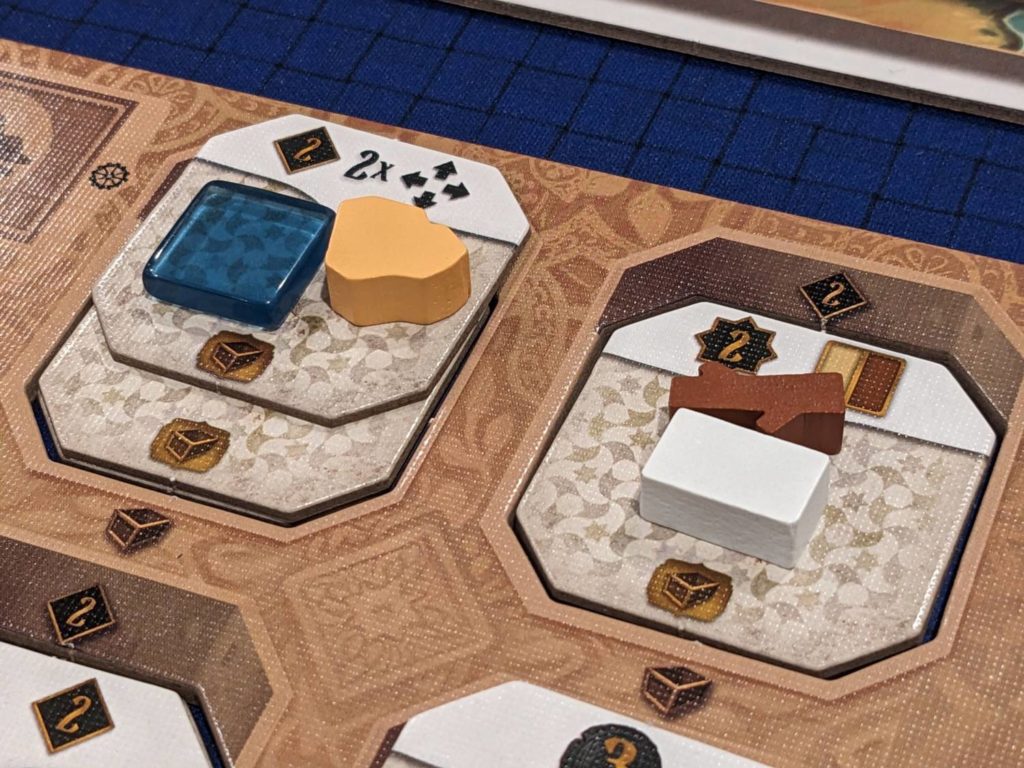
You score when you activate new trade routes. You’ll score on many of the one-time bonus poems. You score end-game points for milestones. You’ll score points when you move up on the Sultan’s Favour track. You’ll sometimes score points and not realize that you are owed points.
Yes, this last bit happens a lot. That’s because Sabika does something that no other game I can think of does: you’ll score points not only when you buy or use cards and tiles, but you’ll also score for the types of materials used to acquire those cards and tiles.
Let me explain. Let’s say you spend a marble to acquire a minor building card. In every other game I know, the rewards for buying a card come in the form of only the card. In Sabika, you score points not only for that card or tile (immediately, or maybe later), but for how you bought the card or tile. In this case, because you used a marble resource, you’ll get three extra points right away.
But wait! In addition, you could spend another one or two resources—different from the first resource spent—to improve the quality of the construction of that card or the carving of a poem. You might refer to this as overbuying, in a way. If I spent marble, then an extra wood, then an extra glass, that would net me three points for the marble, two points for the wood and four points for the glass, with the complete construction “cost” actually scoring me nine points.
Plus, I still get the points for that card.
So, you’re scoring for tracks, public milestones (set collection), personal milestones (that were acquired from a market), acquired cards, spent resources (!!!), trade routes, processed materials, Storehouses, and leftover resources.
It’s not that scores are necessarily high in Sabika—the scoreboard laps at 80 points, with no 80+ scoring tokens provided, if that helps conceptualize scoring here—but that these scores come from a drip of so many sources. And that’s if everyone remembers to account for everything that each player is doing.
For a game where the action selection on the rondel is relatively straightforward, Sabika is a dense design because it can be hard for newer players to understand all of the ways in which they can score. Like many heavier games, Sabika rewards repeated plays. I was surprised I was competitive in my first game with experienced players, but I picked up a lot of tips and tricks even during that first play.
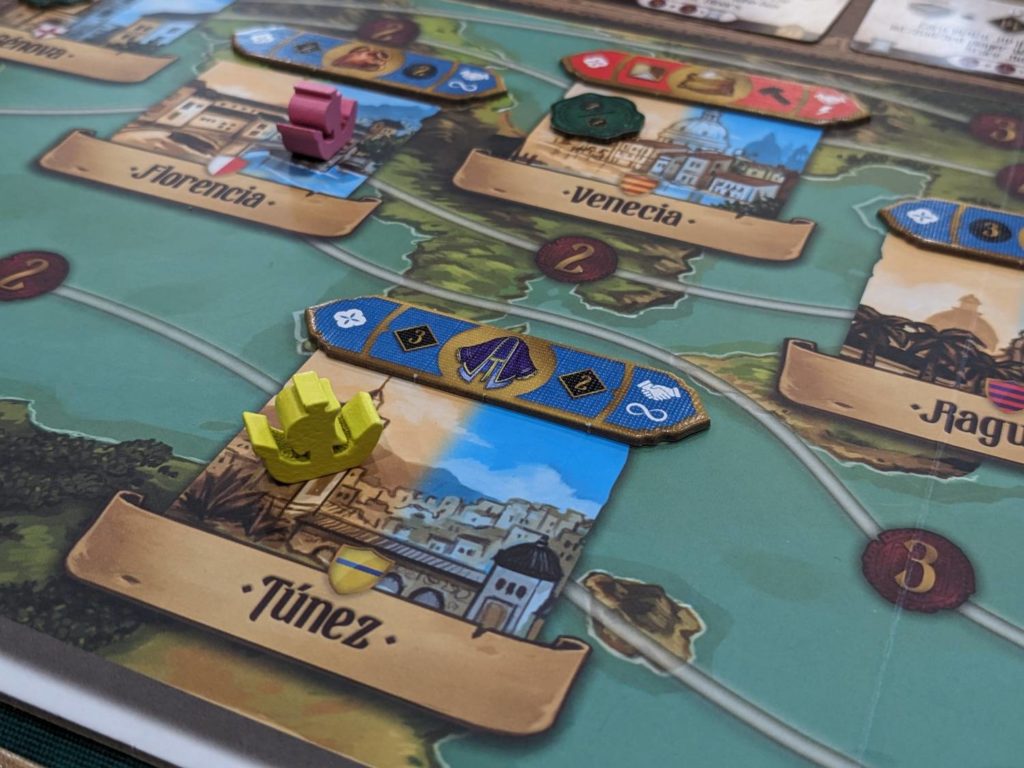
Highly Recommended, But…
Sabika is good. I’m four plays in, and the game is getting stronger after every play.
I absolutely adore the rondel mechanic and the tough choices it presents on almost every turn. The production is solid, the main actions are easy to teach, and the variance in the public milestones for the trading/export actions mean that each game will be a little different from the next one.
With two or three decisive players, Sabika can be played in under two hours, and I think the juice is worth the squeeze in that time window. My first three-player game featured a player who was more deliberate in their turn taking, and that led to a two-hour, 45-minute experience that really dragged at times. I shudder at the idea of Sabika at four players; if even one of those players is “AP” prone (analysis paralysis), that could lead to a 3-to-3.5-hour experience that might make me stare at my phone instead of paying attention to the game.
Thankfully, the solo mode here is enjoyable. It’s very easy to administer, and by using some of the advanced play events, you can scale the solo experience up or down quite easily. It also helped me learn the game well enough to know the rules, although there’s one rule that is not included in the solo mode: when the AI places a meeple on a space where you have a meeple, you don’t get a coin like you would in a play with other people.
The scoring mechanics in Sabika are fiddly. Whether one agrees with the term “point salad” or not, the volume of ways in which a player can score may lead to some misses when remembering to account for everything. Some players will be fine with it, especially after repeated plays. It also feels like players go hard on any of the major building tiles that have an action as a reward—it’s not a bug, but it will give many games a similar look as players race to use their Master Builder to start on a building space and build certain tiles first.
As a sight-challenged player (getting older is a killer!), Sabika is really tough for anyone who has the worst seat at the table. There’s a ton of icons, mitigated slightly with the player aids included in the box. But the text on the poem cards is in a font that is difficult to decipher and a bit tiny. Each round, someone is going to have to call out new additions to the poem market so that everyone knows what’s out there. For those with great eyesight, you are set. Me? I am thankful that I usually position myself in a seat closest to where I have to do the most reading!
If you can find a group to regularly play Sabika, this is a great addition to any Eurogamer’s collection. If you mainly play with casual gamers, this is a tougher call. Sabika is a hard teach, and I don’t think Sabika is great as a once-a-year, dust-off-the-rules experience because the joy is in the efficiency. Stumbling through a game of Sabika would be a rough time at the table.
I’m surprised to say that not many people are talking about Sabika, at least not yet. Maybe expansion content will freshen this up for gamers who tried once and moved on, but I’m hoping to get a few more plays in before the year is out. Now I need to go back and try Bitoku to see how the two designs by Millán compare!


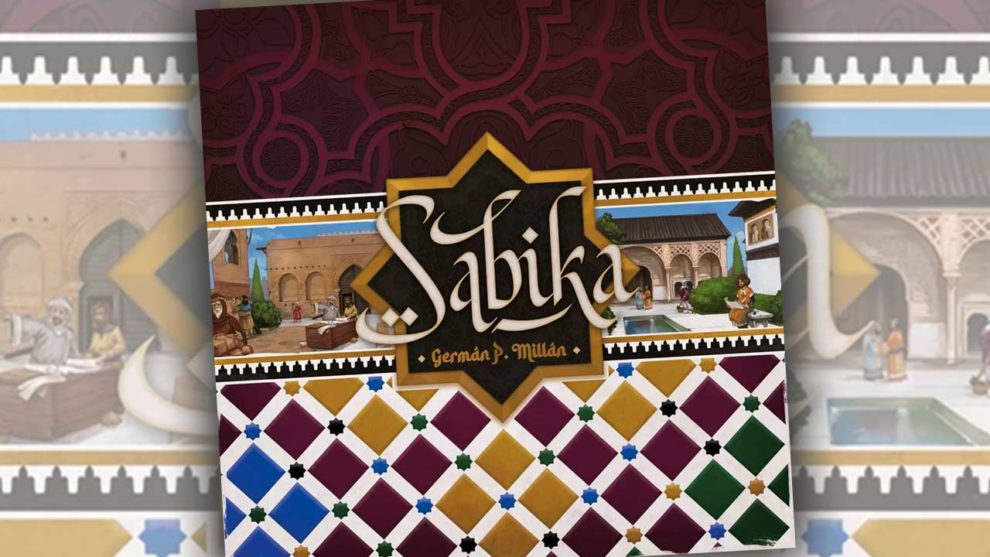


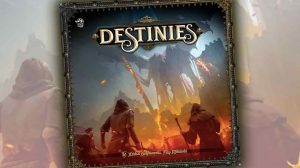






Add Comment